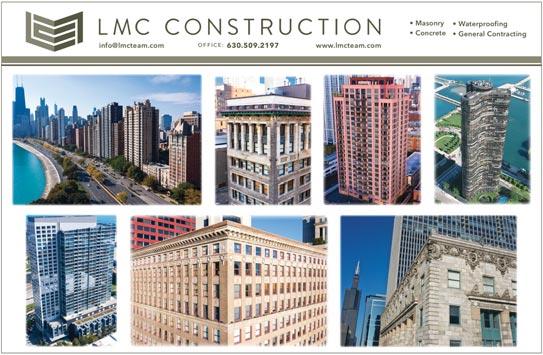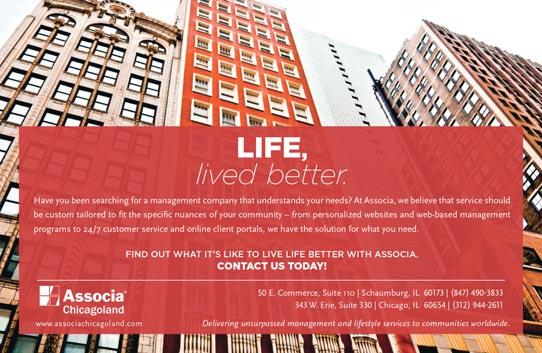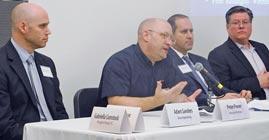
8 minute read
State of the Industry Report; Hot Topics, Trends and Issues for Community Associations


Advertisement
The most recent State-of-the-Industry took place at the historic Chicago Cultural Center on Thursday, December 12. Attendees were greeted by information tables that provided expertise on topics such as fire protection and life safety, disaster restoration, exterior building restoration and maintenance, mechanical systems, association law, bulk energy purchasing and more.
After a catered lunch buffet, the welcome message and opening remarks were delivered by Michael C. Davids, president and founder of MCD Media. He formally opened the program by thanking attendees, event organizers, media guests and MCD Media Advisory Board members for their support and participation. Special recognition was given to the event sponsors.
“Our purpose here today as the name of our event implies is to gain information about the state of our industry,” he said. “It’s a great opportunity for all of us to express our views and perspectives, to learn and share, and to grow new relationships. As most of you know, information exchange and relationshipbuilding are two of the pillars that MCD Media was built on and operates.” LEGAL AND LEGISLATIVE UPDATE
Association attorney Gabriella Comstock of Keough & Moody, P.C., presented an update on recent court decisions and legislative changes that are impacting associations. byPamela Dittmer McKuen Hot Topics, Trends and Issues for Community Associations stat e industry repor t * 2019 HOT TOPICS, TRENDS & ISSUES FOR COMMUNITY ASSOCIATIONS o f the T he 2019 Condo Lifestyles State-of-the-Industry brought together association professionals, homeowners and volunteers for an enlightening program of education, networking and camaraderie. Now in its 24th year, the event is the signature production of MCD Media, publisher of Condo Lifestyles and Chicagoland Buildings & Environments magazines and websites.

Y A welcome message and opening remarks were delivered by Michael C. Davids, president and founder of MCD Media.


Y Shown here are members of the panel discussing industry trends and hot topics. (From L to R) Marshall Dickler, Matt Panush, Mike Bonick, Pete Santangelo, David Barnhart, Howard Dakoff, Peter Power, Adam Sanders and moderator Brian Butler.
“Legislative issues and government regulations are always an important part of what we discuss here at the program each year, and we did see some significant new laws and court rulings pertaining specifically to community associations and some not so specific to community associations that are still impacting us,” Davids said.
This year’s most-talked-about issues included the legalization of recreational cannabis, assistance animals, and manager licensing. Not as prevalent this year were rulings and statutes designed to protect community association owner rights and to guard against actions of some boards from being too heavy-handed, but the trend is expected to continue, he said. (Comstock’s presentation is reported in a separate article in this issue.)
Another State-of-the-Industry tradition is the panel discussion during which leading professionals offer their insights and views on the most pertinent issues facing practitioners, board members and associations. The panel was introduced and moderated by Brian Butler, vice president of property management at FirstService Residential of Illinois.
The 2019 panelists were: Michael Bonick, architect and vice president at Kellermeyer Godfryt Hart; Peter Power, president at Klein and Hoffman; Adam Sanders, project engineer and team leader at Elara Engineering; Peter Santangelo, president at Community Advan

tage at Wintrust; David Barnhart, vice president of condominium management at The Habitat Company; Matthew Panush, senior property tax analyst at Worsek and Vihon; Marshall Dickler, association attorney and senior partner at Dickler, Kahn, Slowikowski & Zavell Ltd.; and Howard Dakoff, association attorney and partner at Levenfeld Pearlstein.
“Managing Expectations During Capital Projects” was the theme of the discussion. An edited version follows:
After introducing the panel and recognizing Dickler for celebrating 50 years as an attorney, Butler asked what types of capital projects they and their client associations are working on. Their collective answers included plumbing (riser) pipe replacements, boilers and chillers, roof replacements, window replacements, facade and masonry repairs and—to a lesser extent—elevator modernization and lobby and hallway updates.
Adam Sanders: When people think of plumbing riser projects, they think about the riser and branch pipe that goes to the individual bathrooms and kitchens. But a lot of times there are horizontal distributions at the bottom and tops

of buildings that need to be taken care of. Those projects usually become very costly as well as very inconvenient. There is a lot of invasiveness to it. Those projects require quite a bit of forethought. Peter Power: Roofing replacement has been steady this past year, and we have a pretty solid backlog going into next year. We also do a fair amount of window replacement projects in occupied buildings. Those are generally one of the largest capital expenditures a building can incur and something that impacts the residents on a personal basis. The projects takes a lot of coordination from start to finish. They are very long running projects. Q: Mike, what types of activities do you recommend for boards and buildings that are planning to undertake a capital project to help residents understand the process and how it will impact them? Michael Bonick: If you’re doing it right, you should be planning these projects like a facade project at least a year in advance. I have found communication with boards and residents is vital. I compare it to voting. Vote early and vote often. Especially if you’ll be levying a special assessment or getting a loan, or if you’re going to take their balcony away for an entire summer, have a town hall meeting way before you even get bids and do the project to let them know this is coming. Then you can have a town hall again when you’ve got plans in place and a contractor, and then have another town hall to tell them how much it’s going to cost. Just keep getting in front of them will help managers so much because you’ll have fewer questions. Y Pictured here (from L to R) is Adam Sanders, Peter Power, Howard Dakoff and David Barnhart.

Q: Peter, at Klein and Hoffman, how do you manage expectations? Peter Power: I would totally agree that it’s constantly staying in front of the residents. Open mic nights, where anyone can stand up to the microphone and state their opinion, as long as it’s done in a professional manner, I think work well. When I attend one of those I find myself repeating the same answers over and over and over, but I think it’s effective. There are going to be people who are for the project and people who are against it, and you’re never going to change their opinions. It’s the group in the middle that are the ones you are trying to influence as far as making decisions. It’s the naysayers who are the loudest in communities, so you want to get the people who are for the project to speak just as loudly.
Q: Adam, what is your advice for structuring a town hall meeting? Sanders: We have found it very important to have the entire project team at those meetings. For riser projects, we’ve done town hall meetings with the engineer, general contractor, plumbing contractor, building management and building engineers. Even though you distribute the literature and you’re very forthright in telling people what is going to happen, not everybody reads it or looks at it, so everybody wants to come and ask questions. Typically, we stay until there are no more questions. Like Pete said, you are answering the same question multiple times in one night, but eventually people start picking up on what those answers are.

Q: Howard, what are some ways of dealing with difficult people during a capital project? Howard Dakoff: Most difficult residents, once they are educated will still be angry but they are usually more cooperative. There is always going to be a small subset of difficult and uncooperative residents, and that’s what legal remedies—fines or litigation—are for. In the 20-plus years I’ve been practicing condominium law, we have only had to file a lawsuit once to gain access to a unit. Up until that point, it was always constant badgering letters, threatening letters, saying we have a right to access your unit, and if you don’t let us, we’re going to fine you and hold you liable for consequential damages for contractor delays. If you do have to sue for access, you will get it. It just may take a little time. Q: From a legal perspective, how do you approach a project like riser replacement? Dakoff: You need to know whether the project is an owner cost or an association cost. The answer depends on your condominium declaration. On a riser project, you are going to have branch lines. Sometimes those branch line repairs or replacements are an owner cost. Most of the time it is a common cost, but you need to know. Q: Dave, from a management perspective, what are some of the considerations on a riser project? David Barnhart: Many owners and board members forget the plumbing part is the small part of the job. It’s just replacing piping. Getting things Y Shown here here is moderator Brian Butler of FirstService Residential leading the panel discussion.









